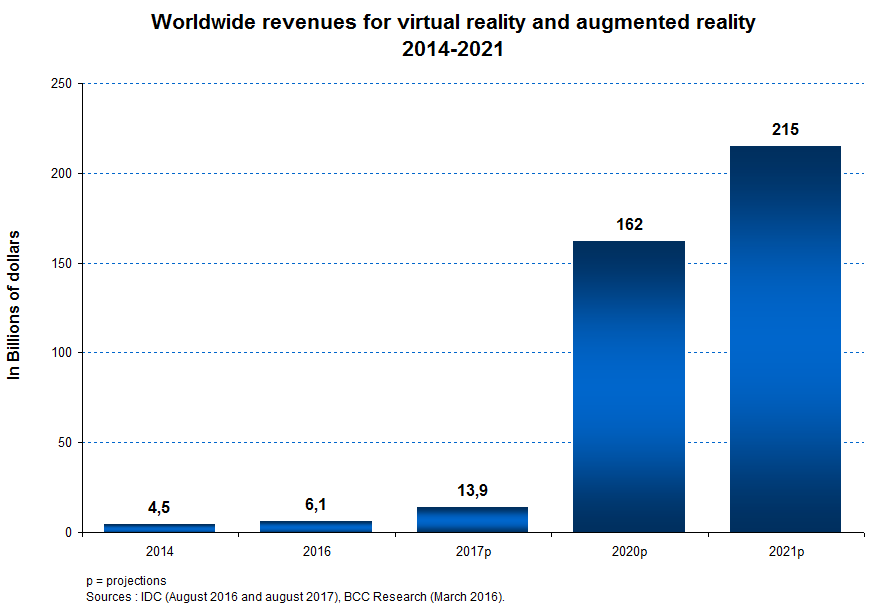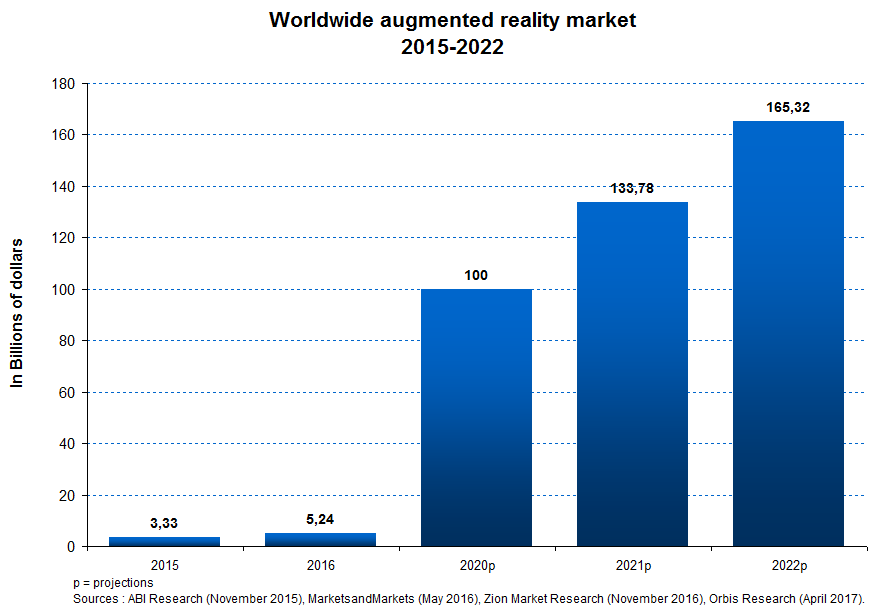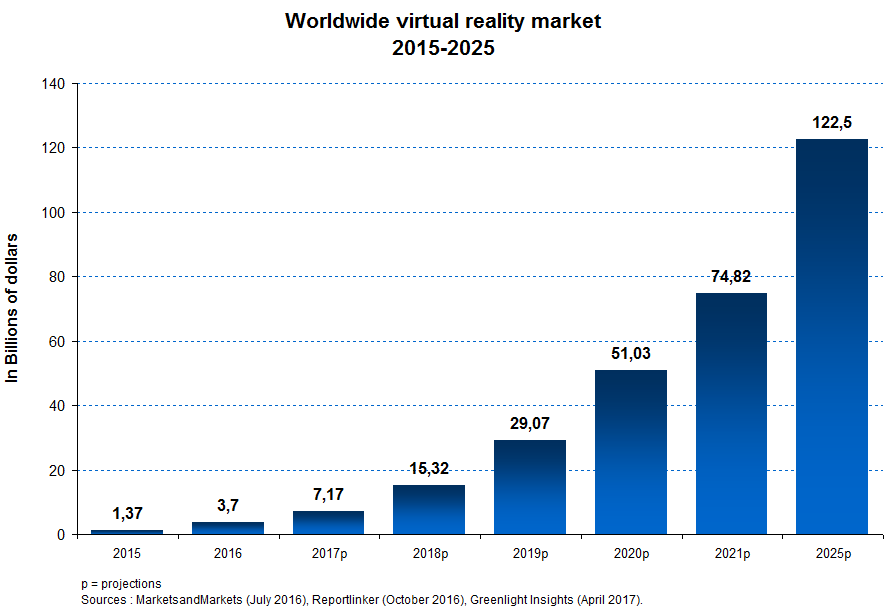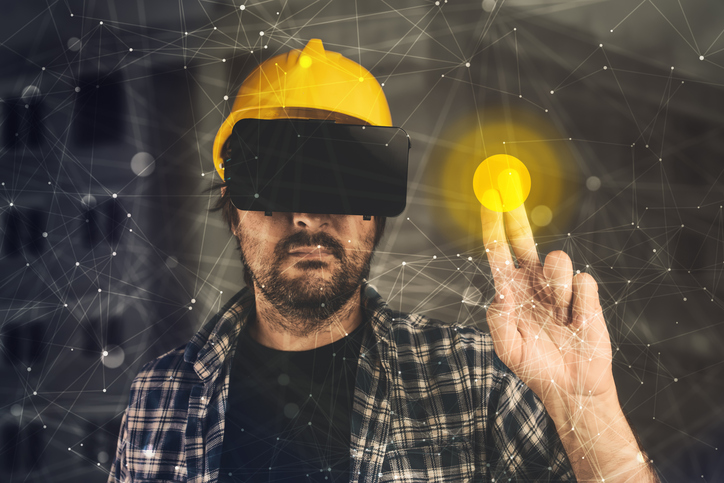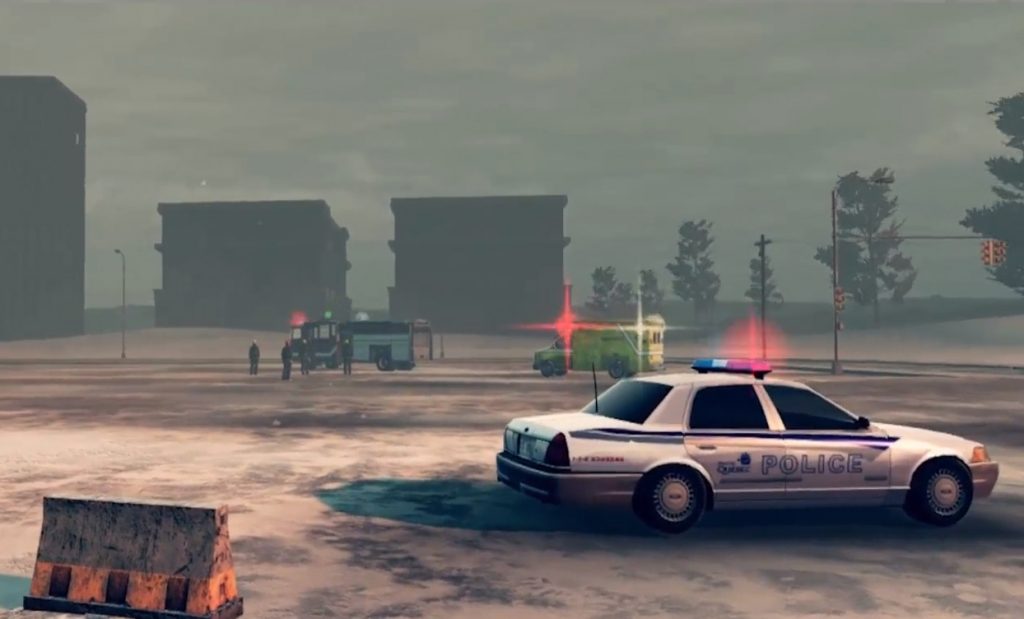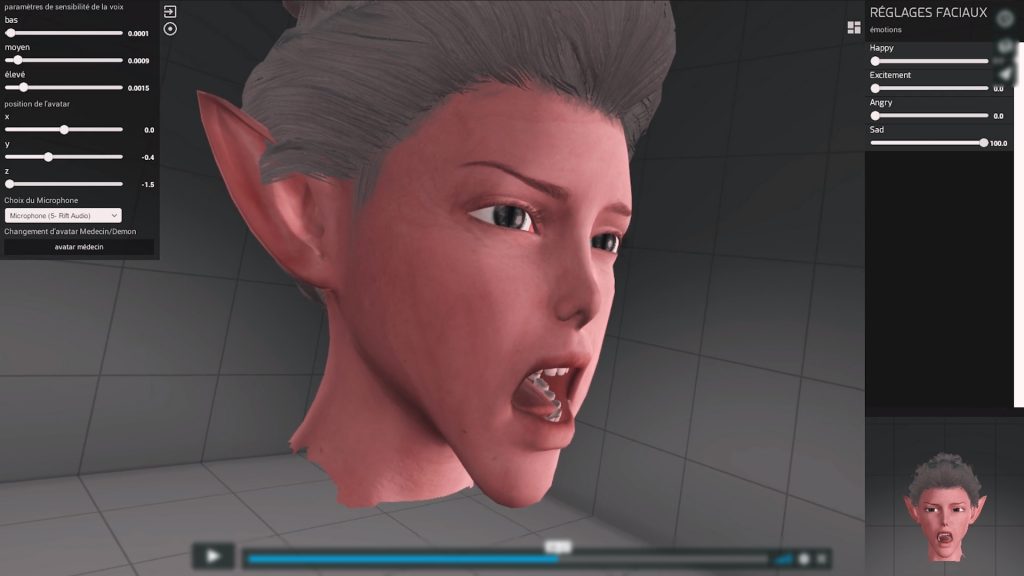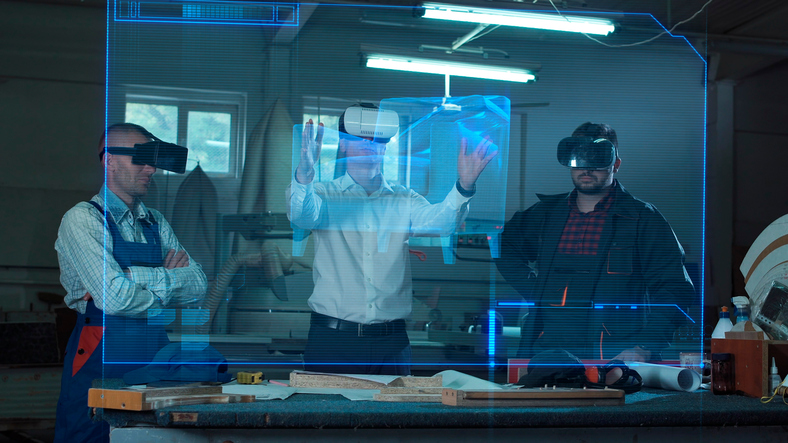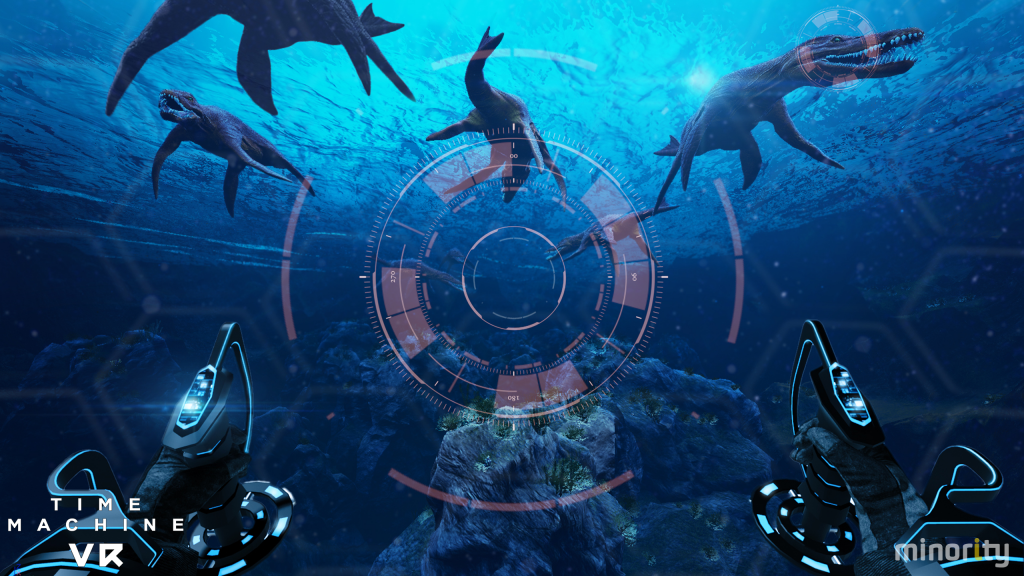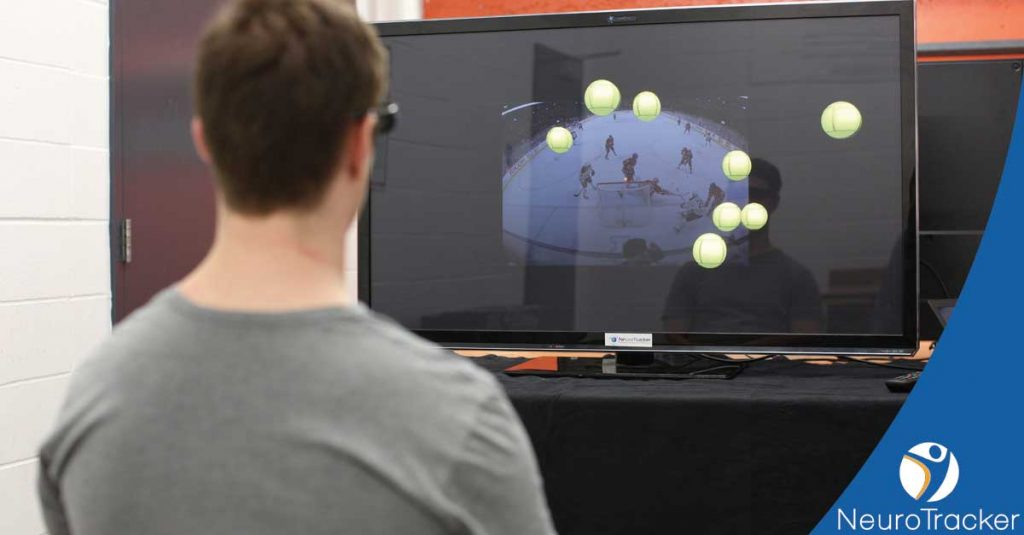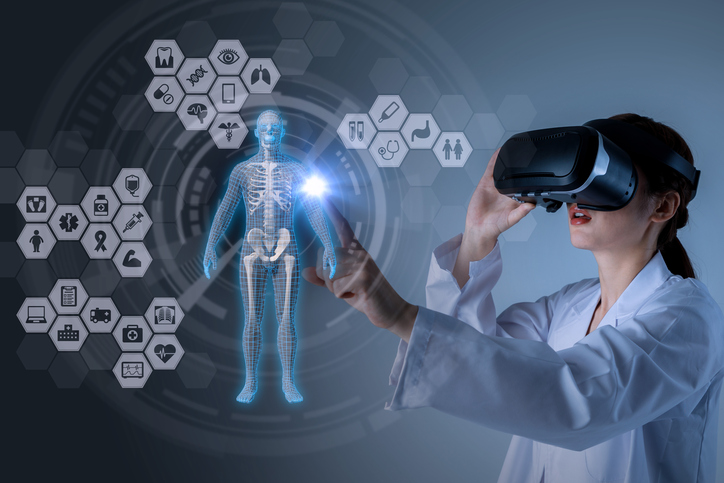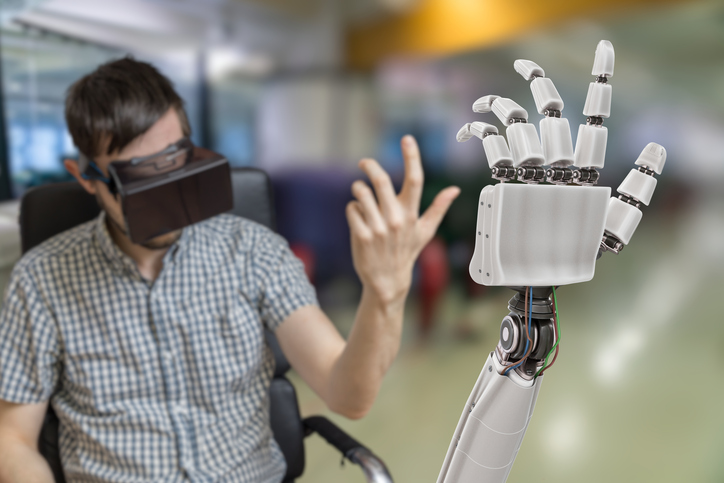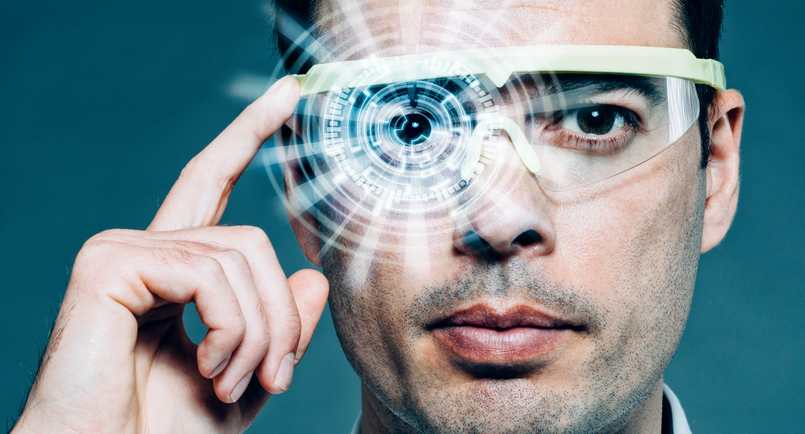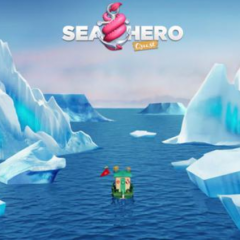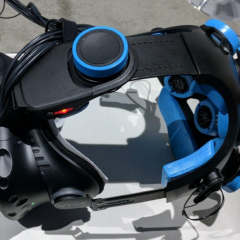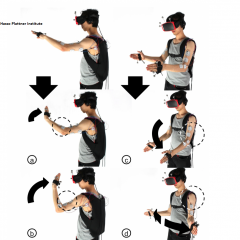Virtual reality and augmented reality are among the technologies making a transformational impact on numerous activity sectors. Together, the two technologies account for an enormous market.
According to estimates from the firm IDC, the global market for these technologies could reach more than $162 billion by 2020. And while the technologies are not recent, they’re being driven forward by multiple technological advancements made in recent years. That’s been the case with smart phones and artificial intelligence, which draw on recent developments in gesture and pattern recognition.
Virtual reality and augmented reality are destined to revolutionize applications in several economic fields. Initially associated with video games, they now offer tantalizing prospects across a broad spectrum of fields, including the development of specialized skills, immersive advertising, and live surgical procedures, while helping advance leading-edge scientific research.
Furthermore, they offer multiple advantages, including the following:
- Cost optimization with increased productivity
- Time savings
- Capacity to target individual factors associated with specific problems
- Ease of assessment and training on complex tasks in specific sectors
These advantages and the sheer diversity of virtual reality and augmented reality applications have captured the attention of high-tech industry giants. Increasingly, companies such as Facebook, Google and Microsoft – each of which has offices in Montréal – are staking out a position in this burgeoning market though investments and acquisitions. In the meantime, innovative small- and medium-sized enterprises (SME) have entered the fray, with Montréal – already a major hub for leading-edge high-tech research and development – making a strong showing in this regard.
To better understand these technologies, it’s important to be able to distinguish them from one another, and citing concrete examples of applications is the best way to know where the differences lie.
Definition
- Virtual reality is a totally immersive experience that transports the user into an imaginary world in three dimensions (3D) created by a software program inspired, as much as possible, by reality. It generally requires the use of a headset into which virtual objects (e.g., images, videos) are projected and with which the user can interact in real time.
- Augmented reality consists of enriching the real word with virtual information created by a software program with the objective of intensifying the user’s understanding of and interaction with his or her environment. It usually involves the use of special glasses, a computer, tablet or smart phone to which virtual information has been added to provide further information to the user. In this regard, the sense of vision, in particular, is brought into play.
- Mixed reality, also known as hybrid reality, is an environment in which objects from real and virtual worlds can co-exist and interact. A mixed reality device is capable of detecting the user environment in order to project interactive virtual information into it. Mixed reality requires the use of a device, such as glasses with transparent lenses, to visualize virtual objects projected in the form of holograms.
Examples of Applications
-
In virtual reality
| Fields | Applications |
| Education/training |
Use virtual reality for technical training purposes or state-of-the-art training of future medical personnel, notably in relation to specific surgical procedures. |
| Real estate/Interior design |
Stage a virtual visit of a future residential unit before a real estate project is completed. |
| Health |
Offer behavioural therapies geared to persons with conditions such as depression, anxiety, phobias and schizophrenia. |
-
In augmented reality
| Fields | Applications |
| Retail trade |
Using a tablet equipped with augmented reality, the user can visualize an article of clothing from all angles and personalize its design (style, colour, etc.). |
| Manufacturing |
Augmented reality glasses make it possible to be there at every step in the manufacturing of a product. Employees are thus able to know all the tools required to design the product and reproduce the steps involved in manufacturing it. |
| Tourism |
Augmented reality lets the user discover the history of a place or a work by pointing a smart phone camera at it. |
This article – the first of two publications on the subject – is meant to present a non-exhaustive showcase of Montréal’s know-how in virtual reality and augmented reality. The city is already a world-renowned hub for video games, and it can draw on the digital creativity and innovation of its actors to position itself favourably in this emerging growth market. In order to gauge the significance of virtual reality and augmented reality, Part 1 analyzes the global market for these two technologies, while Part 2 highlights the technologies with high potential aready present and under development in Montréal. Part 2 showcases innovative companies as well as leading-edge research and development.
VIRTUAL REALITY AND AUGMENTED REALITY: FAST-GROWING INDUSTRIES
Virtual reality and augmented reality accounted for a global market worth $4.5 billion in 2014, and that figure should reach $14 billion in 2017, good for an annual growth rate of 46% over three years. This market is widely expected to undergo accelerated growth in the next four years (2017-2021), with an average annual growth rate of 98% and a global market reaching $215 billion by 2021. According to various economic analysis firms, the augmented reality industry’s global revenues will surpass those of the virtual reality industry, even though higher growth is predicted in the latter industry.
According to the firm Goldman Sachs, three sectors – video gaming, live events and entertainment – will be the chief beneficiaries of this growth. These technologies will be used, increasingly, in other strategic sectors, including in real estate, health, logistics and distribution, education, defence, and engineering.
The global market for augmented reality was worth an estimated $3.3 billion in 2015 and could reach $100 billion by 2020, which is equivalent to an average annual growth rate of 97% per year. By 2022, the augmented reality industry’s global revenues will exceed $165 billion, with an annual growth rate of 29% between 2020 and 2022.
The global market for virtual reality was pegged at $1.4 billion in 2015, and that figure is expected to increase by an average of 129 % per year between 2015 and 2017, reaching $7.2 billion by 2017. In the four subsequent years, from 2017 to 2021, the global virtual reality industry will account for a market worth $75 billion, which is equivalent to an average annual growth rate of 80% over four years.
MONTRÉAL-BASED INNOVATIONS TRANSFORMING SEVERAL SECTORS
The growth of virtual reality and augmented reality is spurring creativity and innovation in several sectors of Montréal’s economy. Be it in the development of specialized services or equipment, the solutions take aim at a variety of concrete issues concerning continuing education and the digitization of factories, to cite just a few examples. Montréal-based companies and researchers are drawing well-deserved notice in various sectors, including health, manufacturing, state-of-the-art scientific research, and engineering.
Greybox | 3D environments for continuing education and predictive maintenance
Greybox is a Montreal-based company that innovates in the design of digital solutions for a variety of industries, including aerospace and health. It builds on recent advances in virtual reality and artificial intelligence to design virtual environments for learning complex processes for companies such as Bombardier, Gulfstream, Airbus, Dassault, Boeing, and others. More precisely, the company has modeled the environment of an aircraft in three dimensions (3D) by integrating different devices such as virtual reality helmets, procedures, scenarios and sensors. The designed tool is then hosted on a cloud computing platform accessible from mobile devices such as tablets and interactive screens. In the context of smart factories, such training environments aim to eliminate certain aspects of logistics, such as access to aircraft parts for staff training which has historically proven to be very difficult to arrange for an a timely fashion and which would otherwise be very expensive for a training organizatio0n to purchase. Virtual and/or Augmented Reality environments facilitate better collaboration between trainers and students (Instructors) and enable accurate, rapid and efficient replication of complex tasks that need to be simulated in training.
According to Greybox, these virtual learning environments offer many benefits to, both, training organizations and students while promoting better learning and comprehension of complex tasks.
Operational benefits for organizations:
- Increase in profits
- Optimization of the ratio of the number of instructors required per students
- Elimination of the need to purchase or rent expensive training equipment
- Elimination of the need for operations departments to make provisions for equipment to be taken off the line to support training operations
- Reduced risk of equipment damage or injury to personnel during training
Benefits for learners:
- Increased motivation
- Better knowledge retention because training is more practical
- Multi-user real-time interaction
- Mobility (e.g.: distance learning)
- Safe/risk-free environment to learn from mistakes
Regulation that could promote recognition of virtual learning methods:
- These training methods could be increasingly recognized by the authorities to take the place of traditional “hands-on” training method as is already common practice, for example, via the use of aviation Full Flight Simulators
So far, virtual environments designed by Greybox apply primarily to the aerospace industry with CAE as a major partner. However, they could be very useful for other sectors such as health, notably for the training of medical personnel, an industry for which Greybox is already highly respected in predictive medicine, AI and digital health.
OVA | The democratization of virtual reality and augmented reality for purposes of training and scientific research
Québec-based OVA specializes in the development of sophisticated software solutions used to create virtual and simulated environments in three dimensions (3D). In collaboration with various college centres for technology transfer (CCTT) and university centres with expertise in virtual reality and augmented reality, the company has developed the StellarX simulation platform featuring various functionalities, including real-time interaction and collaboration, data analysis, or tracking the actions of participants. The StellarX platform – which uses Oculus Rift and HTC Vive headsets and a HoloLens headset (respectively) to operate its virtual reality and augmented reality components – has been applied in a variety of fields, such as public security, industrial operations, and health, to simulate employee training.
In collaboration with the Ville de Québec, for example, police officers, firefighters and ambulance attendants were jointly trained to effectively manage a potential crisis involving a gas leak in a public space. The participants were given virtual reality headsets and teleported into an arena with avatars with the objective of training them to better collaborate with one another in an emergency situation. The simulation achieved the following results:
- Lower costs and simplified logistics: In-person simulations always involve complex logistics and a considerable number of employees, trainers and costly equipment (e.g., emergency vehicles). The fully virtualized OVA simulation required only one trainer for four learners at a time.
- Collaboration: Employees with different organizations tend not to collaborate naturally during training sessions or workplace emergency situations. This simulation thus encourages collaboration between workers across all sectors so as to ensure the transfer of knowledge applicable to real situations.
Patients with schizophrenia also stand to benefit from this technology. In spite of medication and multiple treatments, some such patients continue to hear voices. As part of the “Avatar 2.0” project carried out jointly with the Institut universitaire en santé mentale de Montréal, OVA integrated virtual reality into a tool used to treat hallucinations among people with this mental illness. The company developed a virtual reality application that allows patients to construct a representation of their hallucinations, without any specific aptitude for or knowledge of drawing. The model is true to the patients’ hallucinations, and it lets them develop mechanisms meant to banish their “demons.” The project, while still in the test phase, will help improve the quality of the digital experience, but it will also make it possible to compare virtual therapy with a more traditional cognitive-behavioural approach.
According to the company, virtual reality and augmented reality are lending a new dynamic to several industries, not least security, defence, health, and education. These technologies could pave the way for more effective knowledge transfer while creating context-specific immersive simulations that accurately model risky situations or emergencies, to cite just a few examples. In every case, however, the technologies are still in their infancy. OVA and its StellarX platform constitute a solid basis upon which to master these new worlds.
Rachid Aissaoui and Dassault Systèmes | Virtual ergonomics for digital factories
The development of computer-aided design (CAD) spawned the need to include ergonomics in simulation tools. CAD and simulation tools make it possible to visualize and optimize a product, piece of equipment, factory, or (more generally) a project in three dimensions (3D) before it is fully realized. Virtual ergonomics, meanwhile, can be used to design future work stations, interfaces, or control rooms, by allowing ergonomists, interior designers and industrial designers to identify problems stemming from the interaction between objects in the environment and users executing specific tasks (e.g., drilling, screwing). For example, virtual ergonomics can be used to ensure that industrial products are comfortable, safe and effective for a target population. One of the key elements for analyzing the ergonomics of a product or a task lies in integrating virtual mannequins into a 3D environment where postures are associated with task-specific requirements.
As part of a joint research study with Montréal-based Dassault Systèmes (3DS), the team led by Professor Rachid Aissaoui intends to make the most of recent advances in virtual reality to reproduce certain facets of human sensory-motor behaviour, using a virtual simulation tool. This study is aimed at developing a positioning motor capable of integrating human biomechanical and visual-perceptual-motor behaviour. One such behaviour takes several aspects into account, including object detection and prehension (e.g., postural balance control, speed of movement), physiological constraints specific to the model’s Degrees of freedom (e.g., shoulder rhythm, dependencies between DOF), as well as the relationship between prehension, the objects to grasp (e.g., form, initial/final position, functional characteristics) and the task to execute (e.g., obstacles, force to apply). The development of this motor will make it possible to generate plausible repeatable postures for the user in a timely and intuitive manner. As much as possible, a plausible posture is one that resembles, from a biomechanical standpoint, a posture that a human would use to execute a given task. The repeatability aspect implies that two different users executing the same task with the virtual mannequin must end up with identical postures.
Overall, the project is structured around three areas:
- Integration of “visual-perceptual-motor” behaviour
- Integration of the physiological constraints inherent in the virtual mannequin’s DOF
- Automatic determination of task-specific hand and body posture
This research study will result in the development of a solution that better simulates a factory environment in order to create, monitor and virtually control all production processes.
Minority Media | Virtual reality and augmented reality in public entertainment
Montréal-based Minority Media has been working in the video gaming sector since 2010. In 2013, the company shifted its focus solely to virtual reality and augmented reality, becoming a pioneer in geolocalized virtual entertainment.
Minority Media achieved worldwide success with Time Machine VR in 2017, penetrating the Chinese VR arcade market with an adaptation for D-BOX, the Canadian leader in motion systems. This success sparked keen interest in the company’s three subsequent titles, Chaos Jump and two others not yet announced. Minority Media’s products are prized by major VR arcade operators and international theme parks and movie theatres, notably in China and Taiwan. Prior to entering the VR arcade market in 2016, Time Machine VR was released across all the main virtual reality platforms (cable and mobile), including Oculus Rift, HTC Vive, PlayStation VR, and Samsung Gear VR. In the same year, the game was among the 30 top-selling games in this fast-growing market.
As the first Montréal-based gaming studio to invest in virtual reality, Minority Media has developed rare expertise and know-how applicable to numerous fields, notably scientific research and education. For example, the modelling of prehistoric creatures in Time Machine VR has helped advance university-based research in the hydrodynamics of swimming systems used by aquatic creatures from the Cretaceous and Jurassic periods.
Thanks to financial support from the Canada Media Fund (CMF), Minority Media has been able to foster ties with such technological and digital industry titans as Facebook, Google, Sony, Samsung and HTC. The company has a bright future, with expansion underway in China and the United States.
CogniSens | NeuroTracker, a virtual optimization system for perceptual and cognitive abilities
- What is the meaning of NeuroTracker?
NeuroTracker, an individual cognitive and perceptual training software, is the result of more than 20 years of research by Professor Jocelyn Faubert at the Université de Montréal. Among humans, these abilities tend to decline with age, following a trauma, or in the presence of an attention deficit with or without hyperactivity (ADHD). Designed to isolate and train attentional mechanisms related to vision, this immersive three-dimentional (3D) training system lets the user boost the speed at which a visual scene is analyzed, increase concentration time, and strengthen the ability to mitigate emotional responses. It is thus aimed at improving performance and the treatment of neurological disorders.
Indeed, several studies have demonstrated that this kind of training can have positive effects in various spheres of daily activity. It can improve attention span among users, for example, as well as visual information processing and decision-making, thanks to 3D tracking of multiple objects. What’s more, the training system can measure cognitive integration gains during training. These baseline cognitive skills are vital for treating people with concussions, managing symptoms among patients with ADHD, or optimizing athletic performance.
- Who can benefit from NeuroTracker?
NeuroTracker may prove useful in a number of activity sectors, including health and well-being, defence and security, education, and even scientific research. Thus, anyone wishing to improve their cognitive abilities – athletes, servicemen and servicewomen, law enforcement officers, children with autism or ADHD, etc. – can benefit from this technology.
- Successful commercialization in sports
For the past seven years, NeuroTracker has been marketed by Montréal-based SME CogniSens, drawing users mainly from the sports sector. There are more than 500 NeuroTracker installations worldwide, and clients include the United Kingdom’s Manchester United Football Club, the Montréal Impact, the Vancouver Canucks, and the Canadian Olympic Committee.
- What does the future hold?
CogniSens’s original professional version of NeuroTracker was geared to the sports and defence industries. The company is currently working to adapt the NeuroTracker system so that it can deliver a product for general public consumption. Moreover, in order to step up its activities in the health sector, the company is looking to collaborate with the video gaming industry, which has a vast network of users. In fact, the integration of virtual reality into gaming could prove useful in the rehabilitation of seniors with specific disabilities or deficits.
Jocelyn Faubert | Virtual reality for improved research on human behaviour
Professor Jocelyn Faubert, holder of the NSERC-Essilor Industrial Research Chair on visual function and director of the Université de Montréal’s Laboratoire de psychophysique et de perception visuelle (Faubert Lab), is conducting research on various human behavioural problems observed among different age groups (youth, at-risk seniors, athletes, etc.). His research on perceptual-cognitive training, postural balance, and multisensory function is aimed at identifying the factors at the root of various neurological disorders (e.g., decline in cognitive ability) that affect behaviour, with the ultimate goal of improving human performance.
Professor Faubert uses virtual reality as a tool for understanding, identifying and improving human behaviour in specific situations. Virtual reality lets him gauge complex parameters and determine whether perceptual-cognitive learning in a three-dimensional environment (3D) is an useful approach for achieving concrete gains in human decision-making. In the health field, for example, his expertise can be used to better understand the impact of various neurological changes in order to improve the ability to manage information, for example among people with autism or people who’ve suffered a stroke or a concussion. This research work is being used to develop treatment tools that allow people to maintain their autonomy and lead active social lives. The Faubert Lab – the holder of some 20 patents in the field – is perhaps best known for its already marketed NeuroTracker technology (described above), and the lab is poised to launch its NeuroTuner product in the near future.
- The NeuroTuner, an interface for optimizing perceptual and cognitive function through multisensory integration
The NeuroTuner interface lets the brain link information from several sensory and/or motor stimuli in order to better represent the real world. It is designed to activate a natural mechanism present in all humans (known as the “fulcrum principle”), which helps improve perception and cognition as well as motor reflexes, imagination and creativity. NeuroTuner is thus intended to improve perceptual-cognitive performance, but also the treatment of diseases through the integration of various sensory stimuli (stimulated hearing, touch, vision, etc.). Professor Faubert and his team have successfully demonstrated that auditory stimuli can facilitate the sensation of visual, tactile and postural stimuli. Other researchers have also shown that this type of stimuli can facilitate imagination and creativity.
This invention – which is still under evaluation – will be integrated into a virtual reality environment. The NeuroTuner can be applied for purposes of training in various surgical procedures where laparoscopy – the use of a small tube equipped with a camera – is practiced. Laparoscopy can be performed using a virtual reality interface coupled with auditory stimuli. To date, the tests carried out have demonstrated a 15% improvement in the performance of this procedure. In addition, the NeuroTuner will be paired with the NeuroTracker to allow the latter to achieve better results in the form of optimal speed thresholds during cognitive training.
David Labbé | Virtual reality for improved rehabilitation
École de technologie supérieure (ÉTS) Professor David Labbé and his group of researchers at the Centre de recherche de l’Université de Montréal (CRCHUM) are using virtual reality to improve motor performance. More specifically, their research is aimed at improving cognitive performance among athletes and rehabilitation outcomes among people who’ve suffered a stroke (CVA).
- Virtual reality to mitigate the risk of injury among athletes
Professor Labbé’s team has successfully demonstrated that virtual reality can be an effective tool for reducing the risk of injury among athletes. In this instance, virtual reality is used for cognitive training purposes by recreating complex scenes that allow athletes to manage a significant amount of information across their visual field. According to Professor Labbé, athletic performance is improved when the brain is not overtaxed. Using the NeuroTracker solution developed by Montréal-based SME CogniSens, Professor Labbé and his team recreated game situations in which athletes can track a great deal of information in their visual field, without draining their cognitive resources. By optimising cognitive performance, athletes free up cognitive resources and apply them to motor control, thereby improving their performance in a game situation and reducing the risk of injury.
- Virtual avatars for smart walking
Professor Labbé and his team are also drawing on advances in virtual reality to address long-term motor dysfunctions, for example asymmetrical walking among people who’ve suffered a stroke. The researchers used virtual avatars to demonstrate how this technology can assist in the rehabilitation of stroke victims. The avatars make it possible to manipulate the patients’ visual perception of their own bodies in order to automatically change their motor commands. In other words, a patient’s nervous system can be taught to better execute the walking movements required. The idea underlying this research is to promote a natural gait among these patients by acting on their motor control.
To prove that virtual reality can help in the rehabilitation of walking, the researcher and his team are currently studying two ways to modulate the movement of the avatars:
- First, by gradually reducing the deficit. In other words, the avatar’s parameters are modified in such a way that patients can see themselves executing the improved movement. At this stage of the rehabilitation, the avatar’s gait is closer to that which the patient is attempting to produce than it is to the gait that it is capable of producing.
- Secondly, by exaggerating the deficit. Thus, seeing his or her deficit increase, the patient will attempt to reduce it by making a greater effort. The avatar’s gait, in this case, is more asymmetrical than that of the patient.
As the study is still in progress, improved parameters must be identified to modify the avatar. This may involve the patients’ leg movement, step length, and even muscular activity. What’s more, in collaboration with the Institut de réadaptation Gingras-Lindsay-de-Montréal (IRGLM), Professor Labbé plans to carry out proof of concept trials to ensure that the lab results are applicable to reality.
Professor Labbé’s research findings will lead to the development of new generations of virtual and augmented reality systems that improve the lives of people with conditions affecting motor function.
Rachid Aissaoui | Virtual reality for improved mobility among wheelchair users
Professor Rachid Aissaoui, a member of the ÉTS and CRCHUM Imaging and Orthopædics Research Laboratory (LIO), is drawing on advances in virtual reality to develop state-of-the-art technologies for use in health. More specifically, he is working to improve mobility among manual wheelchair users who have suffered a stroke or are living with other disorders or pathologies, such as osteoarthritis. Some patients with neurological disorders or major spinal cord injuries are reduced to using a wheelchair for the remainder of their lives. They face lengthy rehabilitations during which they must learn the proper posture for mobility all over again. In general, manual propulsion in a wheelchair is a repetitive task calling for movements that are not natural and that entail considerable energy expenditure, not to mention an elevated risk of shoulder injury, which further impairs the user’s ability to perform daily activities.
- An innovative medical simulator
In order to analyze major rehabilitation problems experienced by manual wheelchair users, Professor Aissaoui brought his focus to bear on people with spinal cord injuries. He and his team have developed a ground-breaking haptic simulator capable of monitoring individual strength during propulsion and analyzing the way the user propels his or her wheelchair. Ultimately, this research is undertaken with the aim of optimizing propulsion so that it requires less effort and exerts less strain on the shoulder, thereby reducing energy expenditure.
Professor Aissaoui made use of various technological tools to achieve this goal, including a virtual reality headset and different types of sensors. Virtual reality makes it possible to integrate individuals into a mobile environment, such as a park or building corridor. The immersive environment provides the patients with visual feedback similar to that of the real world, thus giving them better control of the forces they draw upon for propulsion. Moreover, to gauge the different parameters in real time, they use a variety of sensors that measure joint movement, muscular activity, and reaction force on the wheels of the wheelchair. The sensors are connected to a software application that lets the researcher and his team modify the direction of the force applied to the back wheels of the wheelchair so as to produce muscular synergies adapted to each individual.
The results of this research were submitted to a proof of concept study. In collaboration with the Institut de réadaptation Gingras-Lindsay-de-Montréal, the simulator was successfully tested in a clinical study carried out with 18 people with a spinal cord injury. The participants included 16 men and two women partially or fully diagnosed, presenting an average age of 42.4 and an average weight of 77.4 kg.
The researcher and his team were able to effectively modify wheelchair propulsion patterns. An immediate improvement was noted in the patients’ locomotor skills, thereby allowing them to operate their wheelchairs with minimum effort. However, these tests, carried out over several hours, must be duplicated in a clinical setting in order to demonstrate that the haptic simulator has a persistent or long-term effect. The next phase, prior to the installation of the simulator in a rehabilitation centre, will be carried out in collaboration with industry.
- From the laboratory to clinical applications
Professor Aissaoui believes that the transfer of knowledge will result in the simulator being used as a clinical tool in rehabilitation centres. However, securing involvement from stakeholders in this field presents certain challenges associated with knowledge transfer, notably in relation to continuing professional training of clinical personnel, the pairing of training with leading-edge technologies, and the administrative burden of licencing the medical instruments. But it’s safe to say that these research findings will ultimately make it possible to improve the quality of life of persons with a mobility impairment, as well their participation in socioeconomic life.
Philippe Archambault | Virtual reality for improved rehabilitation and timely social integration
Philippe Archambault, a researcher affiliated with the Centre for Interdisciplinary Research in Rehabilitation of Greater Montréal (CRIR) and professor at McGill University, is using virtual reality for purposes of rehabilitation. His research is geared to developing virtual environments that facilitate a safe person-environment interaction for wheelchair users.
Professor Archambault has designed a virtual reality simulator that teaches the user to use a motorized wheelchair and evaluates the use thereof in virtual environments. The virtual scenes created unfold in various places used by the individual in his or her daily life, such as a shopping mall, a bathroom, or a pedestrian crosswalk. The researcher used various digital devices to generate his findings, including sensors and three-dimensional (3D) virtual interfaces. Virtual wheelchair learning exercises were evaluated among a diverse adult cohort with differing physical disabilities, including people with spinal cord injuries or multiple sclerosis. The test results were positive in that people who trained using the simulator improved their driving skills with an actual wheelchair. This technology was developed to promote timely social and economic integration among people living with a disability, and it has the advantage of being inexpensive. It can also be used in a clinic or directly in a patient’s home. The researcher and his team are continuing their research with the aim of adapting the technology to manual wheelchairs. The prototype under development will automatically connect the propulsion applied by the wheelchair user to the virtual wheelchair. During training, the user will be able to observe his or her errors when faced with obstacles in real time and learn to go around them.
Virtual reality and augmented reality are technologies with strong potential, and a number of prominent Montréal actors have staked out a position in this burgeoning field. The manifold applications they’ve come up with across a broad spectrum of fields relevant to the city’s economic activities speak to Montréal’s creative dynamism and spirit of innovation. The technologies outlined here – from specialized training to the modernization of traditional sectors with digital technologies, to diagnostic or prevention tools used in health – showcase Montréal’s know-how in this emerging growth sector.
Montréal is a North American leader when it comes to high-tech expertise – the city has long been a video gaming and visual effects hub – and it is well positioned to make the most of recent advances in virtual reality and augemented reality. The city is home to a talented and creative workforce, a flourishing digital ecosystem, and a critical mass of researchers in prestigious fields, such as software engineering, artificial intelligence, and form recognition. In a context where innovation plays an increasingly key role in competitivenes, it is essential to draw on a diverse array of optimization levers. Virtual reality and augmented represent one such lever. The next article will cover the same subject and present other technologies that attest to the potential and variety of applications developed in Montréal.

